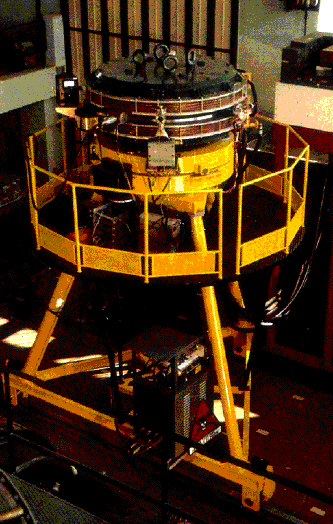

The construction of ADA, the first storage ring for an electron and a positron beam rotating in opposite directions on the same trajectory, was proposed in 1960 by Bruno Touschek (1921-1978) , who pointed out the extreme scientific interest of high energy collisions between particles and antiparticles, and the simplicity of realisation of such an accelerator.
The machine was conceived as a feasibility experiment to provide a sound basis for the realisation of electron-positron colliders of larger center of mass energy and luminosity. A first stored beam of few electrons was obtained at the end of May 1961, using the Frascati Electron Synchrotron as an injector.
In order to detect with reasonable statistics the interactions of counterrotating electrons and positrons, ADA was then shipped to France, at the "Laboratoire de l'Accelerateur Lineaire" of Orsay, near Paris, where a high intensity linear accelerator was available. With some 107 stored particles in both beams, the first electron-positron interactions were observed at the beginning of 1964.
ADA is essentially a large weak focusing bending magnet, capable of keeping particles up to 0.25 GeV on a circular orbit of 65 cm radius. A stainless steel vacuum vessel is inserted between the magnet poles, where the pressure was brought down to ~10-10 Torr. A radiofrequency cavity with a longitudinal field oscillating at 147 MHz with a peak voltage of 5 KV compensated the energy loss due to synchrotron radiation emission from the stored particles.
ADA pointed out some new aspects of accelerator physics, in particular those connected with the interactions between particles in the same beam. It was discovered that the beam lifetime decreased when the density of the stored particles was improved. Touschek was able to explain this phenomenon (today called "Touschek effect" or "intrabeam scattering") as due to transverse scattering of the particles inside the beam, with sufficient energy exchange to escape from the longitudinal acceptance.
This storage ring prototype was able to demonstrate not only the feasibility of electron and positron accumulation, but also the effectiveness of the crossings in terms of particle-antiparticle reactions. The only detectable reaction in ADA was the single photon production from an electron-positron interaction (single beam-beam bremsstrahlung): the rate of such events was found to be in agreement with the calculated cross section and storage ring parameters.